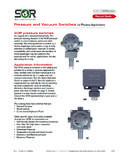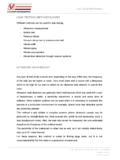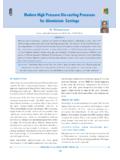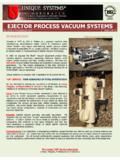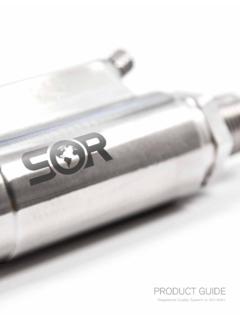Transcription of Vacuum Box Test Procedure - bmt-tank.com
1 Vacuum Box Test Procedure Date: 8/26/09 Revision: 2 PURPOSE This Procedure will be used to perform Vacuum Box Testing when required by contract or specification. REFERENCE SPECIFICATIONS API 650 Latest edition API 620 Latest edition AWWA D-100 Latest edition Latest edition STI-SP031 Latest edition Procedure SCOPE This Procedure specifies the technique, acceptance criteria and documentation requirements which apply to Vacuum Box Leak Testing. The object of this technique is to locate leaks in welds due to through thickness discontinuities.
2 This is accomplished by applying a solution to a weld and creating a differential pressure across the weld causing the formation of bubbles as leakage gas passes through the solution. This testing is to be performed prior to any main vessel or tank testing following the completion of all welding. Items to be examined in accordance with this Procedure will be indicated on the drawings. PERSONNEL Personnel performing this test shall be experienced in performing this method of examination and shall be familiar with this Procedure .
3 The operator shall have vision (with correction if necessary) to be able to read a Jaeger 2 standard chart at a distance of not less than 12 inches. Operators shall be checked annually to ensure that they meet this requirement. The operator shall be proven competent in the technique of Vacuum box testing, including performing the examination and interpreting and evaluating the results; however, where the examination method consists of more than one operation performing only a portion of the test needed to be qualified for that portion of the operator performs.
4 TEST MATERIAL- BUBBLE SOLUTION The bubble forming solution shall produce a film that does not break away from the area to be tested, and the bubbles formed shall not break rapidly due to air drying or low surface tension. The number of bubbles contained in the solution should be minimized to reduce the problem of discriminating between existing bubbles and those caused by leakage. Vacuum Box Test Procedure Date: 8/26/09 Revision: 2 The bubble forming solution shall be one of the following: For carbon steels, a commercially prepared leak testing may be used, or a solution with a ratio of one (1) part Joy, Ivory liquid soap, or similar soap product to one hundred (100) parts of the following: a.
5 Water- for testing welds with surface temperatures between 40 F (4 C) and 125 f (52 C); or b. A solution containing approximately 30% alcohol and 70% soapy water will be used for testing welds when the surface temperatures is less than 40 F (4 C). For stainless and nickel steels and for carbon steels when required by contract, a commercially prepared leak testing solution with low chloride, halide and sulfur content, such as Leak Tec 277NE, Bubble Emission Leak Detector. Commercial solutions shall be used only within the temperature ranges recommended by the manufacturer.
6 TEST EQUIPMENT The Vacuum box used shall be of convenient size and contain a window in the side opposite the open bottom. The open bottom edge shall be equipped with a suitable gasket to form a seal against the test surface. Suitable connections, valves, lighting and gauge shall be provided. The gauge should preferably have a range of 0-15psi (0-1 bar) or a range of 0-30 inches (0-762 mm) of mercury. A Vacuum pump source shall be used; preferably a variable one which will achieve the required Vacuum pressure. PREPARATION FOR THE TEST All welding shall be completed before the Vacuum box examination is to begin; this shall include, but not be limited to cleaning all welds of slag, spatter dirt, oil, grease, paint or other contaminants that might mask a leak.
7 The welder and/or welding machine operator is responsible for cleaning their own welds prior to Vacuum box testing. Testing shall not be performed on wet surfaces because the liquid may tend to dilute the leak detection solution. The temperature of the weld surface to be examined shall be between 40 F (4 C) and 125 F (52 C), unless the film solution is proven to work at temperatures outside these limits, either by testing or manufacturers recommendations. Local heating or cooling is permitted. Vacuum Box Test Procedure Date: 8/26/09 Revision: 2 TEST Procedure The bubble forming solution shall be applied to the surface to be tested by flowing, spraying or brushing, the solution over the examination area before placement of the Vacuum box.
8 The solution shall not be applied more than one minute prior to testing so that evaporation or freezing of the solution does not occur. A partial Vacuum of 21 KPa (3 lbf/in. 2/6 in. Hg.) to 35 KPa (5 lbf/in. 2/10 in.) gauge shall be used for the test. If specified by the Purchaser, a second partial Vacuum test of 56 KPa (8 lbf/in. 2/16 in. Hg.) to 70 KPa (10 lbf/in. 2/20 in.) shall be performed for the detection of very small leaks. The required partial Vacuum (differential pressure) shall be maintained for at least 10 seconds of examination time. Examination time shall be, at a minimum, the duration of time necessary to visually scan the entire increment under examination during initial pressurization and stabilization, as well as any additional time required for de-pressurization and re-pressurization needed to resolve standing bubbles.
9 An overlap of at least 2 inches of previously viewed surface shall be used for each subsequent examination to assure complete coverage. A minimum light intensity of 1000 Lux (100 fc) at the point of examination is required during the application of the examination and evaluation for leaks. (This light intensity can be provided by a LED head lamp at 2' or a 1000 watt halogen light at 6'). ACCEPTANCE CRITERIA The presence of continuous bubble formation or growth on the surface being examined indicates leakage through an orifice passage(s) in the area under examination.
10 Any indicated leakage shall be considered unacceptable. Some large leaks may not be detected by bubble formation because the strong stream of air may break the bubble film as soon as it forms. To avoid missing this type of leak, the pressure shall be monitored for a variation (decrease). REPAIRS AND RETEST All indicated leaks, regardless of size, shall be marked and repaired by relieving the pressure, removing the defective weld, and re-welding using qualified welding procedures , welders and welding operators, and re-inspecting for acceptance.

